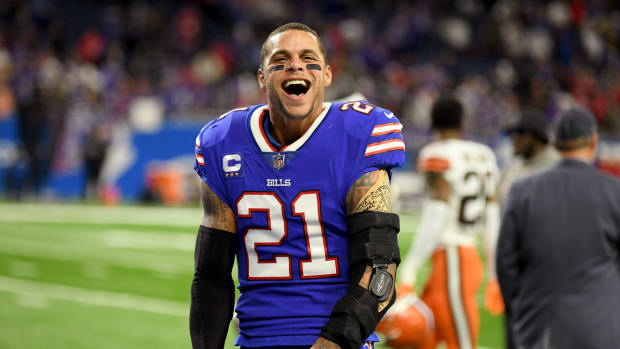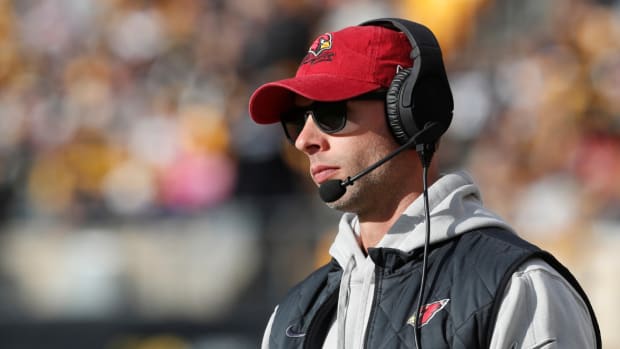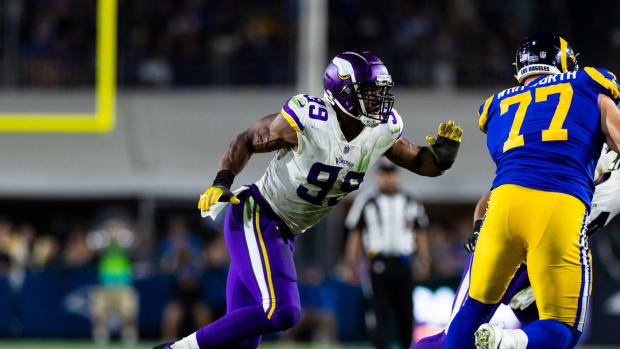The Launching of Matt Patricia
The MMQB is on the road to Super Bowl 52. Follow along on Twitter, Facebook, Instagram and Snapchat (@TheMMQB), and find all of our road trip content here.
TROY, N.Y. — On a chilly Monday morning, students are settling into their seats in Room 330, a lecture hall in the Darrin Communications Center, one of Rensselaer Polytechnic Institute’s classroom buildings. Professor Kurt Anderson is standing at the front of the room with his materials for the day: an overhead projector and five markers, in addition to a rainbow-colored ball and metallic hoop that, respectively, represent the Earth and the orbit of a spacecraft.
“We are going to start off with what I call the two-body problem,” Anderson tells the room of approximately 75 students, “which is an engineering approximation for how our celestial mechanics work.”
“Spaceflight Mechanics” is now in session. It’s a course that RPI undergraduates majoring in aeronautical engineering take in the spring semester of their junior year—the type of class that Matt Patricia, defensive coordinator of the New England Patriots, would have taken as an undergrad on this campus in the 90s.
Patricia’s reputation as the only rocket scientist coaching in the NFL precedes him. He graduated from RPI in 1996, earning his degree from the School of Engineering’s Mechanical, Aerospace and Nuclear Engineering Department, while also suiting up as an undersized offensive lineman for a football team that then played its games on a tiny field a few steps from this classroom (capacity: 1,000). The school’s mascot, appropriately enough, is the engineers; the lyrics to a fight song include “sine,” “cosine,” “square root” and six digits of the mathematical constant pi.
Patricia, whose first job was as an application engineer at Hoffman Air & Filtration Systems in Syracuse, N.Y., took an unconventional path to his current job—not to mention the one he’s lined up to accept at season’s end, head coach of the Detroit Lions. But most would agree that the lessons learned in college stick with us, no matter how incongruous the application to our present-day lives might seem. So, the Monday after the Patriots advanced to Super Bowl LII—the sixth Patriots Super Bowl trip Patricia has been a part of—we visited the place where Patricia would have used his famous yellow No. 2 pencil to take a very different kind of notes more than 20 years ago.
The two-body problem, the subject of today’s lecture, may sound to football fans like a defensive strategy to take away the opponent’s best receiver (cover Antonio Brown with two bodies!). In this classroom, however, it’s a model for the motion of two objects with a gravitational force between them, such as a satellite or the moon orbiting the Earth. Using his blue marker, Anderson is writing across the overhead projector film the equations that describe this motion, according to basic laws of physics like the conservation of energy and angular momentum.
The class is nearly two hours long, but most of the students are listening intently—if your mind wanders, by the time you snap back to attention the professor will have already rolled the projector screen, moving on to the next set of equations. Anderson, who is wearing a pale yellow tie adorned with Leonardo Da Vinci’s engineering drawings, has a PhD from Stanford and is known by his students for having worked on several “top-secret” spacecraft research programs. This morning, he makes frequent references to how they’ll apply what he’s teaching to future jobs in industry—the aerospace industry, in most cases.
Midway through the first hour, Anderson describes a project he was involved in, during which an engineer blindly applied one of the equations they are discussing today without checking that he was using the same reference frame as the rest of his colleagues. “He used a perfectly correct equation incorrectly and got a disastrously wrong result on a real spacecraft,” Anderson warns the class. “Thank goodness it was caught before launch!”
Later, he advises the students that he will dock them credit if they use 24 hours for the Earth’s rotation period, rather than the more accurate 23 hours, 56 minutes, 4 seconds. “The difference between this and 24 hours is pretty bloody small,” Anderson says. “However, it is not sufficiently small [so] that if on Exam 1 you use this value instead of this value, I will take three points off, maybe more.” Those three minutes, 56 seconds, he emphasizes, add up surprisingly quickly. When he instructs the class to use the unit of radians instead of degrees for all angular measurements, one student urgently writes in his notebook, in all caps: ALWAYS USE RADIANS.
The details matter, because the stakes are high. “This is the course they would take to learn how to get a rocket or satellite from point A to point B,” Anderson explains during a five-minute break in the middle of class. In part two of this course, they’ll learn how to design the rocket or spacecraft that would take flight. Perhaps even more starkly, they’ll spend the last 10 minutes of class calculating what the energy of impact would be for an asteroid hitting Earth (disastrous, even for a very small asteroid) and discussing the projected flight path for the next one projected to enter the Earth’s gravitational sphere of influence, in August 2027. (Don’t worry: It won’t hit us, Anderson notes).
When Patricia was learning lessons like these, and pulling all-nighters for exams with the fellow football-playing aeronautical engineering majors in his Theta Chi fraternity house, he wasn’t planning on the industry he’d be building a career in being the football one—though, back then, he showed many of the same attributes then that have since become his strengths as a coach. Scott Sasenbury, the athletics facilities manager who was a teammate and fraternity brother of Patricia’s at RPI, recalls how easily Patricia’s understanding of the game came to him and how well he related to players in the year he spent as a graduate assistant while beginning work on his master’s degree. Before Patriots games, Patricia walks around the field and greets each of his players—the same way his coaches at RPI used to do.
Even if Kepler’s Laws of planetary motion do not specifically apply to Patricia’s current job, though, it’s also hardly a stretch to see a general carryover from his engineering education. Details matter. Fractions of time add up surprisingly quickly. And it’s not an asteroid hurtling toward the Earth, but the stakes are still high to come up with the right calculation for the Jaguars’ fourth-and-15 play with a trip to the Super Bowl on the line.
“Engineers are taught to be logical, to look at data and then find good solutions based on that data,” Anderson says, “and from what I’ve seen on a football field, that is largely what he’s doing, though his system is a little bit more chaotic than the ones I deal with.”
Too bad we’re not visiting in Week 14, Anderson says. The solution of the Newton-Euler equations for an axisymmetric body would perfectly describe the wobble of the football as it travels through the air. For now, he turns his attention back to the two-body problem. It’s an approximation of what happens in real life, he explains, but it’s a pretty good one.
“It provides true insight into what is important, and what isn’t, and why,” Anderson says. “What can we ignore? What’s important?” Football isn’t rocket science, but the questions these RPI engineering students are pondering in this Space Mechanics class don’t sound too different from the ones their most prominent alum is confronting right now in his Gillette Stadium office.
• Question or comment? Email us at talkback@themmqb.com.





































